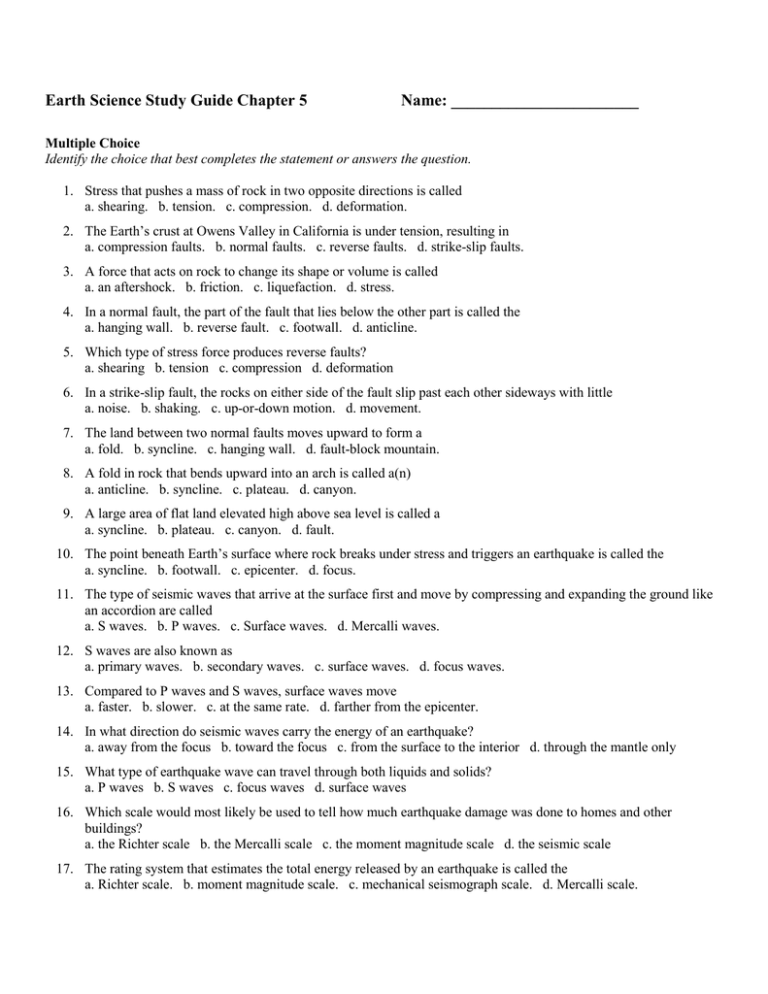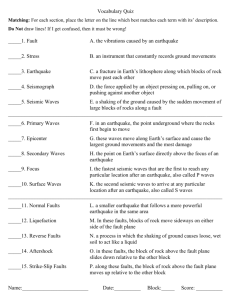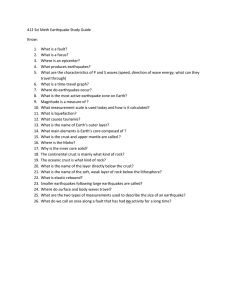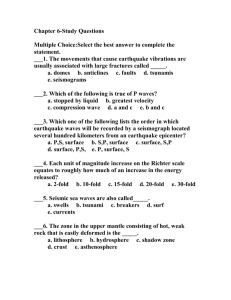Earth Science Chapter 5 Study Guide
advertisement

Earth Science Study Guide Chapter 5 Name: _______________________ Multiple Choice Identify the choice that best completes the statement or answers the question. 1. Stress that pushes a mass of rock in two opposite directions is called a. shearing. b. tension. c. compression. d. deformation. 2. The Earth’s crust at Owens Valley in California is under tension, resulting in a. compression faults. b. normal faults. c. reverse faults. d. strike-slip faults. 3. A force that acts on rock to change its shape or volume is called a. an aftershock. b. friction. c. liquefaction. d. stress. 4. In a normal fault, the part of the fault that lies below the other part is called the a. hanging wall. b. reverse fault. c. footwall. d. anticline. 5. Which type of stress force produces reverse faults? a. shearing b. tension c. compression d. deformation 6. In a strike-slip fault, the rocks on either side of the fault slip past each other sideways with little a. noise. b. shaking. c. up-or-down motion. d. movement. 7. The land between two normal faults moves upward to form a a. fold. b. syncline. c. hanging wall. d. fault-block mountain. 8. A fold in rock that bends upward into an arch is called a(n) a. anticline. b. syncline. c. plateau. d. canyon. 9. A large area of flat land elevated high above sea level is called a a. syncline. b. plateau. c. canyon. d. fault. 10. The point beneath Earth’s surface where rock breaks under stress and triggers an earthquake is called the a. syncline. b. footwall. c. epicenter. d. focus. 11. The type of seismic waves that arrive at the surface first and move by compressing and expanding the ground like an accordion are called a. S waves. b. P waves. c. Surface waves. d. Mercalli waves. 12. S waves are also known as a. primary waves. b. secondary waves. c. surface waves. d. focus waves. 13. Compared to P waves and S waves, surface waves move a. faster. b. slower. c. at the same rate. d. farther from the epicenter. 14. In what direction do seismic waves carry the energy of an earthquake? a. away from the focus b. toward the focus c. from the surface to the interior d. through the mantle only 15. What type of earthquake wave can travel through both liquids and solids? a. P waves b. S waves c. focus waves d. surface waves 16. Which scale would most likely be used to tell how much earthquake damage was done to homes and other buildings? a. the Richter scale b. the Mercalli scale c. the moment magnitude scale d. the seismic scale 17. The rating system that estimates the total energy released by an earthquake is called the a. Richter scale. b. moment magnitude scale. c. mechanical seismograph scale. d. Mercalli scale. 18. What does a seismograph record? a. the Mercalli scale rating for an earthquake b. the speed of seismic waves c. the ground movements caused by seismic waves d. the location of the epicenter 19. A device that uses wire stretched across a fault to measure horizontal movement of the ground is called a a. creep meter. b. laser-ranging device. c. tiltmeter. d. satellite. 20. Which of the following monitors both vertical and horizontal movements along a fault? a. laser-ranging device b. GPS satellite system c. tiltmeter d. creep meter 21. Which type of fault-monitoring device is most like a carpenter’s level? a. tiltmeter b. laser-ranging device c. creep meter d. satellite 22. What happens when friction between the opposite sides of a fault is high? a. A plateau may form on one side of the fault. b. The fault locks, and stress builds up until an earthquake occurs. c. Folding of the crust may occur. d. The rocks on both sides of the fault easily slide past each other. 23. Geologists cannot yet predict earthquakes because a. they have too much data. b. they can’t be sure when and where stress will be released along a fault. c. they need to know where all past earthquakes occurred. d. there are too many faults to monitor. 24. Geologists know that wherever plate movement stores energy in the rock along faults, a. earthquakes are not likely. b. earthquakes are likely. c. an earthquake is occurring. d. an earthquake could never occur. 25. The risk of earthquakes is high along the Pacific coast of the United States because a. there have been no earthquakes there lately. b. serious earthquakes are rare east of the Rockies. c. satellites have detected increasing elevation of the ground surface. d. that’s where the Pacific and North American plates meet. 26. Which of the following can cause damage days or months after a large earthquake? a. the arrival of surface waves. b. liquefaction. c. a tsunami. d. an aftershock. 27. If the Coast Guard warns of a giant wave of water approaching the shore as a result of a major earthquake, they are warning of a. an aftershock. b. liquefaction. c. a tsunami. d. landslides. 28. A building designed to reduce the amount of energy that reaches the building during an earthquake is called a a. fixed-base building. b. wood-frame building. c. base-isolated building. d. brick building. 29. The best way to protect yourself in an earthquake is to a. run as fast as you can. b. drop, cover, and hold. c. go into the basement. d. stand under a tree. 30. Most earthquake-related deaths and injuries result from a. tsunamis. b. damage to buildings or other structures. c. liquefaction. d. P waves. Modified True/False Indicate whether the statement is true or false. If false, change the identified word or phrase to make the statement true. 31. The squeezing together of rocks by stress is called shearing. _________________________ 32. In a strike-slip fault, the rocks on either side of the fault slip past each other sideways. _________________________ 33. An upward fold in a rock is called a plateau. _________________________ 34. When an earthquake occurs, S waves are the first seismic waves to arrive at a given location. _________________________ 35. During an earthquake, seismic waves move outward from the focus in all directions. _________________________ 36. The Richter scale describes the effects of an earthquake on people, buildings, and land at a given location. _________________________ 37. Geologists use a creep meter to measure the horizontal movement along a fault. _________________________ 38. With the range of data available, geologists cannot predict exactly where and when earthquakes will occur. _________________________ 39. An earthquake on the ocean floor can produce a tsunami, which may grow into a huge wave as it approaches the shore. _________________________ 40. A type of building that absorbs the energy of seismic waves is a fixed-base building. _________________________ Completion Complete each statement. 41. The stress force that pulls on the crust where two plates are moving apart is called ____________________. 42. The stress force that causes a mass of rock to pull or twist in opposite directions is called ____________________. 43. The Klamath Mountains in California were produced by a(n) ______________ fault, which is formed when compression causes the hanging wall to move over the footwall. 44. The block of rock that lies above a fault is called the ____________________. 45. Shearing creates ____________________ faults, like the San Andreas fault in California. 46. The Sierra Nevada is a(n) ____________________ mountain range, formed when a block of rock was pushed upward by normal faults. 47. Layers of rock that bend can produce a downward fold known as a(n) ____________________. 48. A valley that dips between two parallel ranges of hills was formed by a downward fold in rock called a(n) ____________________. 49. The seismic waves that travel along Earth’s surface and produce the most severe ground movements are called ____________________. 50. Vibrations that move through the ground carrying the energy released during an earthquake are called ____________________. 51. Earthquake waves that vibrate from side to side and up and down only through solids are known as ____________________. 52. The point beneath the surface where rock breaks and an earthquake starts is the ____________________. 53. The scale that measures the strength of an earthquake based on seismic waves and movement along a fault is called the ____________________ scale. 54. The ____________________ scale accurately rates the size of seismic waves only for small, nearby earthquakes. 55. Geologists use a(n) ____________________ to measure the tilting of the ground along a fault. 56. Laser-ranging devices can detect even tiny movements of the crust along a(n) ____________________. 57. Geologists determine earthquake risk by locating where ____________________ are active. 58. The process in which the violent shaking of an earthquake turns soft soil into liquid mud is called ____________________. 59. An earthquake that occurs shortly after a larger earthquake is a(n) ____________________. 60. Earthquake damage can be reduced by making buildings more ____________________ so that they twist and bend without breaking. Short Answer Use the diagram to answer each question. 61. Describe the rock layers shown in Diagram A and any forces acting on the rock. 62. What caused the rock layers to take on the shape shown in diagram C? 63. Contrast the plate movements that cause the stresses in diagrams B and C. 64. Compare diagram B to diagram A. How is it different? 65. Will a normal fault result from the stresses being applied to the rock unit in diagram D? Explain. Use the diagram to answer each question. 66. How do California and Nevada compare in possible severity of earthquake damage? 67. In which part of Maine should you live if you want the least possible risk of damage from an earthquake? Explain. 68. What kind of risk is shown on the map and how is this risk determined? 69. According to the map, which part of the United States is least likely to suffer earthquake damage? 70. What earthquake damage is Texas likely to suffer? Essay (Answer on a separate sheet of paper. Answers must be in complete sentences and spelling must be correct. Answers may be typed or written neatly in cursive.) 71. Compare and contrast a normal fault and a reverse fault. 72. What is a plateau and how can one form? 73. Distinguish between the focus and the epicenter of an earthquake. 74. Explain the difference between P and S waves in an earthquake. 75. Which is likely to experience more damage during an earthquake, a house built on a solid rock ledge or a nearby house built on a soil river bank? Explain your answer.








